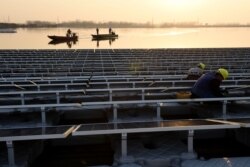Many world leaders are gathering in Madrid, Spain to discuss how to reduce the world’s temperatures. As they meet, China is expected to receive a lot of attention. China is the largest producer of carbon gases linked to rising temperatures.
Development and Energy Mix
China burns about half the coal used in the world each year. Coal is a fossil fuel that releases carbon dioxide and other gases when it is burned.
Between 2000 and 2018, China’s yearly carbon gas emissions increased by nearly two hundred percent. China now releases about 30 percent of the world’s total.
However, China is also the leading market for solar energy devices, wind turbines and electric vehicles. It builds about two-thirds of the world’s solar cells, which create electricity from sunlight.
Kevin Tu is with the Center on Global Energy Policy at Columbia University and works in Beijing. “We are witnessing many contradictions in China’s energy development,” he said. “It’s the largest coal market and the largest clean energy market in the world.”
But China’s government notes that the country’s yearly economic growth has slowed to about six percent. That is China’s lowest level of growth in 25 years. Chinese officials are increasing their support for coal and other heavy industries. That is because those industries are important parts of China’s energy system and economy. At the same time, the country is reducing subsidies for renewable energy.
Recent media reports and satellite pictures suggest that China is building or planning to complete new coal power centers with a total electricity production of 148 gigawatts. That number is nearly equal to all the electricity produced by coal in the European Union. That estimate comes from Global Energy Monitor, a nonprofit organization based in San Francisco.
Separately, investment in China’s renewable energy industries dropped almost 40 percent in the first half of 2019 compared with the same period last year. That information comes from Bloomberg New Energy Finance, a research organization.
Last week in Beijing, China’s vice minister of ecology and environment, Zhao Yingmin, spoke to reporters. He said energy resources that are not based on carbon already make up 14.3 percent of the country’s electricity production. He did not say if China would promise to lower its emissions targets anytime soon.
“We are still faced with challenges of developing our economy, improving people’s livelihoods,” he said.
China and the Environment: Difficult Issues
Critics say China is the world’s biggest producer of gases linked to climate change. Supporters say China is the biggest producer of clean energy equipment. However, both claims are somewhat misleading.
“China has a really mixed record. On the one hand, it’s seen rapidly rising emissions over the past two decades,” notes Jonas Nahm, an energy expert at Johns Hopkins University. “On the other hand, it’s shown it’s able to innovate around manufacturing — and make new energy technologies available at scale, faster and cheaper,” he said.
Bloomberg New Energy Finance says China’s manufacturing helped bring down the cost of solar panels by 80 percent between 2008 and 2013. Prices for wind turbines and lithium-ion batteries also dropped sharply because of Chinese manufacturers.
“If we have any chance to meet climate targets, we have to do a lot by 2030 — and we won’t be able to do it without China’s clean-energy supply chain,” Nahm said.
I'm Mario Ritter, Jr.
Christina Larson reported on this story for the Associated Press. John Russell adapted it for Learning English. Mario Ritter, Jr. was the editor.
We want to hear from you. Write to us in the Comments Section.
____________________________________________________________
Words in This Story
turbine – n. a tall structure that has large blades attached to an engine that is used to produce electricity from wind energy
fossil fuel –n. carbon based fuel formed from dead plants and animals
cell -- n. a device for turning light (such as sunlight) into electricity
contradiction -- n. a difference or disagreement between two things
subsidy – n. money that is paid usually by a government to keep the price of a product or service low or to help a business or organization to continue to function
emissions –n. something that is released into the atmosphere
challenges –n. difficulties, hard issues to solve
livelihood -- n. a way of earning money in order to live
decade –n. a ten year period
innovate -- v. to do something in a new way : to have new ideas about how something can be done








